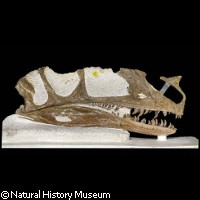Scientists discover T. rex ancestor
Researchers from Germany and the UK have rediscovered a fossil skull in the collections of the Natural History Museum in London, thus unlocking the mystery behind the evolutionary history of the dinosaurs belonging to the Tyrannosauridae family. The research was funded in part by the SYNTHESYS ('Synthesis of systematic resources') project, which received EUR 13 million under the 'Research Infrastructures' Thematic area of the EU's Sixth Framework Programme (FP6). The findings were published in the Zoological Journal of the Linnean Society. The researchers from Ludwig-Maximilians-Universität München (LMU Munich) and Natural History Museum in London used innovative imaging to show that the specimen Proceratosaurus, which looked a lot like its much younger descendant Tyrannosaurus rex (T. rex) is the oldest known relative of the Tyrannosauridae. The skull is 30 centimetres long and 165 million years old. The images showed that the structure of the cranial cavity, as well as the teeth and jaws of both species shared many features. LMU Munich's Dr Oliver Rauhut pointed out that 'Proceratosaurus weighed only about 40 kilograms.' The researchers speculate that both Proceratosaurus and T. rex depended on their powerful biting apparatus, and that they used their skulls as a hunting weapon. 'It is likely that this hunting strategy developed first' in Proceratosaurus, according to Dr Rauhut. 'The basic tool kit was perfected in later tyrannosaurids: The skull became more robust and the jaw muscles larger and, overall, the body increased enormously in size. Proceratosaurus also confirms that the Tyrannosauridae developed over a very long stretch of time, and gave rise to a great diversity of forms. Further members of the family surely await discovery.' While the fossil was misclassified at first, it was later recognised as representing an otherwise unknown genus, and was named Proceratosaurus. Researchers uncovered the skull during excavations for a reservoir close to Minchinhampton in Gloucestershire around a century ago. However, palaeontologists only began investigating the skull in recent years. The work was headed by Dr Rauhut along with Dr Angela Milner of London's Natural History Museum. According to the researchers, the skull could provide information on the life of the Proceratosaurus - the earliest known ancestor of the Tyrannosauridae family. What is clear is that both Proceratosaurus and T. Rex were huge bipedal carnivores, with sharp teeth and short and stubby forelimbs. Thanks to their investigative work, the researchers discovered similar features between Proceratosaurus and T. rex despite the 100-million year difference between them. However, the Proceratosaurus skull was about five times smaller than that of the T. rex. 'It is quite astonishing that this fossil has received so little attention, since it is one of the best preserved dinosaur skulls in Europe,' Dr Rauhut said. The Natural History Museum's Scott Moore-Fay successfully exposed the parts of the skull that were embedded in the rock matrix. 'This is a very fragile skull, so removing the rock, especially from around the teeth, was a delicate and time-consuming task that had to be done under a microscope, using very fine tools,' he said. Dinosaur expert Dr Milner said: 'Computerised tomography is a wonderful method because it offers us a non-destructive means of visualising the internal structures of fossils. It was quite a surprise when our analysis showed that we had the oldest known relative of T. rex. 'We care for over 9 million fossils here at the Museum and this discovery highlights the importance of museum collections in current and future research. Fossils collected a century ago can now be studied again with the benefit of much greater knowledge of dinosaurs from around the world.'
Countries
Germany, United Kingdom



